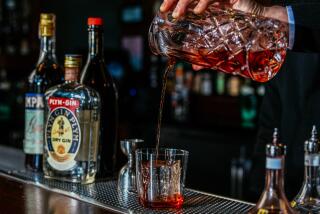Bitters Bottles Often Carry Sweet Prices
- Share via
Question: What role did Jacob Hostetter play in the evolution of the bottle as a collectible?--Y.C.
Answer: Hostetter was a Lancaster County, Pa., physician who concocted a bitters formula for his patients.
As you may recall, bitters were first produced in Great Britain more than 200 years ago. They were of varying alcoholic strength and were usually advertised as potions that could cure a number of illnesses.
Some bitters had low alcoholic content; but others could knock you out of your socks.
In any case, Dr. Hostetter in the 1850s passed his bitters patent on to his son to manufacture commercially. The product, Hostetter’s Bitters, buoyed by heavy advertising, soon became enormously successful.
Bottle collectors seek out the amber (the most common color for bitters bottles) and yellow Hostetter bottles, which, in top condition, can sell for $80 or more. Usually, however, they carry more modest price tags.
The heyday of the Hostetter product, which was between 1860 and 1905, was also the time when more than 1,000 different brands of bitters were marketed in the United States. The bottles usually were embossed with a design and carried the producer’s name. Dealers say that American-made bitters bottles generally command higher prices than those of foreign manufacture.
Mailbag
A piece by this writer that appeared last month in the Metro section of The Times on two leading Los Angeles collectors of walking sticks prompted a note from Cecil Curtis. He said Walking Stick Notes, a newsletter that appears “irregularly and (which) is sent gratis to friends who share our interest” in canes, is available to interested readers. His address: Placebo Press, 4051 E. Olive Road, No. 231, Pensacola, Fla. 32514.
San Francisco Bay Area collector-dealer Ada Fitzsimmons has a timely article about collectible comic valentines in the winter edition of her publication, Paper Pile Quarterly (Box 337, San Anselmo, Calif. 94960).
The valentine, she writes, probably can be traced “back to the 3rd Century and the Christian St. Valentine who was beheaded during the festival of love and purification.”
The comic valentine, she says, evolved by the mid-19th Century to the point where thousands were in circulation.
“It could be sent as a joke both to poke fun and to deliver a crude jab at the same time,” Fitzsimmons writes. Eventually, along with their stark drawings, they “degenerated into the most uncouth, crude humor.”
But highly collectible they are, she comments, not just as paper collectibles but as social comments on a bygone era.
Clyde Hostetter of San Luis Obispo says bookmarks are popular collectibles in Great Britain and in several other European countries.
“Visitors to historic sites, museums, etc., buy the bookmarks as inexpensive souvenirs,” he writes. “The bookmarks have detailed engravings, stamped in gold, of buildings or other objects related to the site.”
Similar bookmarks, he says, are available for $2 or $3 from such places as Hearst Castle and the Smithsonian Institution.
Hostetter says he would like to exchange information about American bookmarks with other collectors. His address: P.O. Box 14433, San Luis Obispo, Calif. 93406.
More to Read
Eat your way across L.A.
Get our weekly Tasting Notes newsletter for reviews, news and more.
You may occasionally receive promotional content from the Los Angeles Times.









